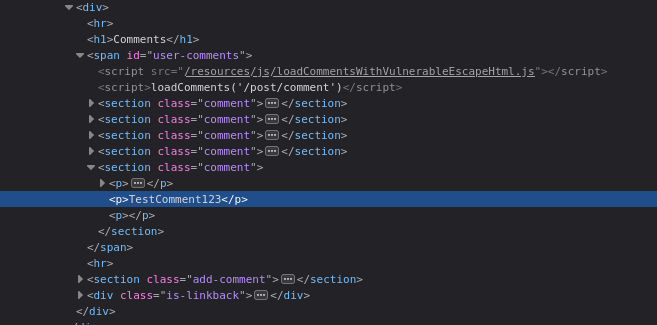Lab: Stored DOM XSS
This lab demonstrates a stored DOM vulnerability in the blog comment functionality. To solve this lab, exploit this vulnerability to call the alert() function.
Solution
Step 1: Access the Blog Page
Once you access the lab, navigate to any blog post. Scroll down to the comment form, where you’ll be leaving your payload.

Step 2: Test the Comment Form
- Fill out the form fields (Name, Email, and Comment).
- In the comment field, enter a simple, identifiable string (e.g.,
TestComment123). - Submit the comment and click Back to Blog to view it.

Step 3: Inspect the DOM
- Locate your comment on the page and right-click it. Select Inspect to examine how it’s processed in the DOM.
- You’ll notice something like this:

The script responsible for processing comments is /resources/js/loadCommentsWithVulnerableEscapeHtml.js.
Step 4: Analyze the Vulnerability
- Navigate to the Network tab, refresh the page, and locate the
loadCommentsWithVulnerableEscapeHtml.jsscript. Examine its response to uncover the following vulnerability:

The.replace()method only replaces the first occurrence of<and>. This means a crafted payload with multiple tags can bypass this sanitization.
Step 5: Craft Your Payload
Using this flaw, create a payload that introduces a harmless tag before your exploit:
<><img src=x onerror=alert(1)>Here:
<><img>uses the bypass to inject a valid tag.onerror=alert(1)triggers the JavaScriptalert()function when the browser fails to load the image.
Step 6: Exploit the Vulnerability
Return to the comment form, and submit the crafted payload in the comment field:

Click Post Comment, then Back to Blog.
Step 7: Confirm Exploitation
Upon viewing your comment, you should see the pop-up window confirming the payload execution. Inspect the DOM to verify the payload is embedded in your comment.

Congratulations!
You’ve successfully exploited the stored DOM XSS vulnerability. The root cause lies in the improper use of .replace() for sanitizing user input.
By replacing .replace() with .replaceAll(), this vulnerability could have been avoided.
